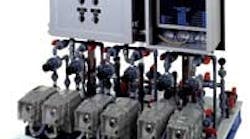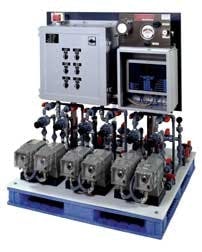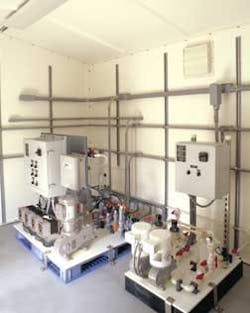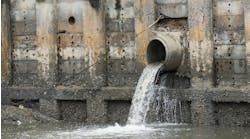For most facilities today, the only constant is change. Managers, facility engineers and maintenance supervisors, swamped with improvement initiatives brought about by ever-increasing competitive pressures, must continuously search for new ways to make improvements in the efficiency and reliability of their plants' processes and systems. Compounding this challenge is the fact that typically far less human resources than ever before are in place to address these initiatives.
Facilities also are facing increased pressure to improve performance in chemical delivery, control and monitoring.
Chemical feed and control essentially entail the introduction of chemicals into various processes at desired ratios to maintain system integrity such as the mitigation of biological fouling, deposits or corrosion. Once you get past the concept stage and proceed to the real world, however, chemical feed becomes far more challenging and complex. However, the area is ripe with opportunities for plants to gain significant performance advantages.
Automation, reliability, optimization & safety
Facilities are updating their chemical feed systems primarily to gain four key advantages: automation, reliability, optimization and safety.
The adoption of automation is proliferating as the result of the decade-long trend toward downsizing. Without the necessary human resources to monitor, analyze and adjust chemical feed rates, facilities increasingly are compelled to adopt ," and trust ," automation. This reality, coupled with advances in microprocessor technology, has driven the development of better, more user-friendly and more affordable automation for even highly customized chemical feed applications.
Paramount to the advancement in automated chemical feed has been the development of and improvements in real-time analyzer technologies. The ability to continuously measure the performance of a chemical being fed and to automatically adjust feedrate appropriately has brought process optimization in the form of performance-based chemical feed control. Only a few years ago, a facility and the water treatment company serving it relied heavily on quantity-based chemical feed control with periodic dosage adjustments. Facilities now have a greater ability to modulate the precise amount of chemical automatically to meet ever-changing system requirements continuously.
Today's automation capabilities help to avoid or minimize damaging events, extending equipment life. Automation also is allowing neat chemical feed in many applications, thereby reducing chemical handling and maximizing operator safety. Plus, control automation and real-time analyzer technologies now facilitate the logging of comprehensive historical chemical usage and pertinent application data to assist the plant with troubleshooting and cost optimization.
To develop new automated feed and control systems, critical understanding of key chemical processes and automated chemical process control is essential.
Re-thinking who does what
As facilities strive to adopt automation and increase reliability, optimization and safety, facility management must re-think the design and procurement process for acquiring these increasingly sophisticated systems. To meet new performance criteria, chemical feed and control systems must be designed and built to meet the specific needs of each application precisely.
But at what cost? Long gone are the days when the required chemical feed expertise rarely extended beyond the boundaries of a pump. Substantial application knowledge is now required to facilitate the needs and requirements of the plant owner, its engineering, procurement and construction (EPC) firm (for new construction), and the plant's water treatment firm. Feed and control systems not only must meet the interfacing requirements of the plant, but also must deliver the types of chemicals at the precise feedrates required by the water treatment firm to meet specific performance criteria while operating within water treatment budgets.
Plants usually issue a specification for chemical feed equipment, and this spec typically contains numerous line items such as pumps, back pressure valves, manual valves, piping, etc. In the past, many plants possessed the in-house resources necessary to manage and coordinate the efforts of a contractor to integrate all these components on-site. Or, in some cases, plants elected to build chemical feed systems in-house.
Today, these approaches might not result in the most efficient chemical feed and control system. Plants and EPCs often must maintain constant focus on the "bigger picture" items such as turbines and process pumps that represent millions of dollars; therefore, it can be difficult to provide dedicated resources and experience for the various small chemical treatment systems that will serve the plant. What is needed today is a way to efficiently shift these burdens away from the plant and the engineer and toward specialists who can facilitate the connection between water treatment application needs and feed system design.
Custom packaged feed systems
Increasingly, facilities are using custom packaged chemical feed systems. Here, the solutions provider designs the entire system specifically for the application and builds it off-site.
After the "modular" system is thoroughly tested, it then is delivered to the plant on a skid. Electricity is established and plumbing connected, and interface connections are made to the plant's distributed control system (DCS) at a junction box (or, depending on the needs and capabilities of the plant, the packaged feed system is designed to include local automated control with wireless interface capabilities).
Although packaged chemical feed skids long have been available, their use was more limited until relatively recently, partly because few companies possessed the necessary skills to provide fully integrated packaged systems. Although some pump manufacturers provide packaged systems, the resulting systems often are not designed with an understanding beyond the boundaries of the pump. However, several full-service packaged system providers have been established over the past several years to meet the need for optimized, site-specific chemical feed solutions.
In addition to providing fully integrated systems that bring reliable, optimized chemical feed and control to critical applications, a knowledgeable packaged system provider often can help plants to:
Achieve best practices efficiently.
Bridge the gap between plant owner, EPC team and water treatment supplier.
Create "pockets of excellence" in older/outdated facilities.
Achieve best practices efficiently
Best practices are built into the packaged solution based on application specifics. Why is the plant feeding the chemicals? How do feeding operations impact operation? What are the flow hydraulics for the application, and are any seasonal variations present?
How do these parameters fit in with construction material selection or dictate the best control regime for the application? All of these specifics, and many others, must be considered by the packaged system provider if the most appropriate solution is to be designed, built and delivered for the particular application.
In addition, features can be included in a packaged solution to add reliability through the use of best practices engineering design. These features include alarm capabilities, feed delivery confirmation, automatic switchover backups, redundant pumps and complete automation packages.
Bridge the gap between plant owner, EPC team & water treatment supplier.
A water treatment firm is not usually selected until plant construction has been completed or is near completion. Consequently, the design of the chemical feed system receives minimal input from the water treatment firm that ultimately will be responsible for chemical feed operations. Once a water treatment firm is selected, it then must operate the systems as designed.
A knowledgeable and experienced packaged feed system provider can apply experience and best practices to efficiently and effectively bridge the gap between plant designers and the construction and procurement arms of the EPC team. As a result, optimization is built into the facility's chemical feed and control processes from the onset.
Create "pockets of excellence."
Self-contained systems can be designed and built to meet the precise needs of the process while also providing local automated control. A variety of different wireless communication options can be incorporated into the system design to allow the plant to monitor and access critical performance data via the Internet or other communications options.
Incorporating these stand-alone systems in areas of the plant experiencing the most problems often can bring results that are both impressive and sustained. Used throughout an aging, outdated plant, these site-specific packaged chemical feed systems can create "pockets of excellence" that bring significant improvements and allow the plant to be competitive in its most critical processes.
A custom packaged chemical feed provider custom designed the entire system shown here.
Creating economies
Some major corporations are buying numerous smaller companies in the water and chemical treatment equipment fields, resulting in tremendous synergies that allow economically efficient approaches to packaged solutions not possible in the past. A few major solutions providers today possess a variety of new technologies "in-house," and have corporate relationships with outside suppliers of critical technologies, equipment and materials, thereby providing far greater buying leverage than was previously possible.
When a system is built on-site, the engineer responsible for the plant must design each chemical feed system and then select, purchase, install and integrate all the components making up these systems, including coordination with numerous suppliers. Proper design and materials selection are vital to system longevity and reliability to maximize the value of the system.
A packaged solution effectively shifts these burdens away from the engineer. It is now the packaged solution provider's responsibility to engineer these systems correctly; the provider "owns" the process until it hands the system over to the plant as a working product. This approach also eliminates the "finger pointing" that can take place between suppliers of components, a frequent headache for plants and engineers when a built-on-site system fails to perform properly.
Choosing a provider
No two packaged feed system providers are alike ," they come in all shapes and sizes ," with varying capabilities. Five key questions you should ask before choosing a provider include:
1) Does the firm possess the technical knowledge required to perform the task efficiently and effectively? Does it view the system as a whole? Can it see "past the pump?"
2) Does the firm have related experience? Is it experienced in designing and building packaged chemical feed systems similar in size and scope to the systems your plant requires?
3) Does the firm possess the organizational depth to provide you optimum service? This includes not only experienced consultants providing you with effective solutions, but also engineers, CAD designers, and installation, startup, service and support personnel providing documentation, drawings and training programs relative to your packaged feed system.
4) Does the firm take "creative" approaches to designing and building integrated systems so customers receive the highest-quality feed system at the lowest practical cost?
5) Does the firm have a sound business philosophy? In other words, is it dedicated to being a true custom solutions provider, or is it simply a technology vendor?
When a facility is searching for a packaged feed system provider, it is looking for a company that possesses specific qualifications in technical knowledge and related experience. To avoid any potential pitfalls, the provider's experience, technical capabilities and trace record should be thoroughly evaluated. References should be checked to verify that design-build work for other customers has been professionally carried out within budget and to the customers' satisfaction. In addition, once a provider has been selected, the scope of work and services required should be thoroughly defined and agreed upon at the outset.
Conclusion
As facilities strive to adopt automation and gain reliability, optimization and safety during an era of shrinking human resources, facility management and EPC firms must rethink the way chemical feed systems are designed, built and procured. Increasingly, effective solutions are being found in the adoption of packaged chemical feed systems. An experienced and knowledgeable packaged solutions provider can offer significant efficiencies, while providing fully integrated systems that bring reliable, performance-based chemical feed to critical applications.
Armenta is a vice president with ," and Demarco is a product manager (OSEC Systems) for ," USFilter Chemfeed & Disinfection Group, Bradley, Ill. Contact them at (800) 882-6466.




